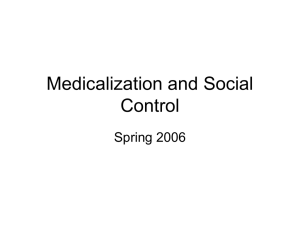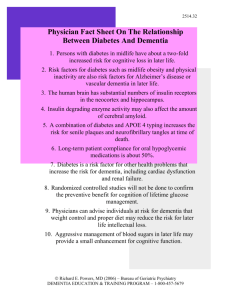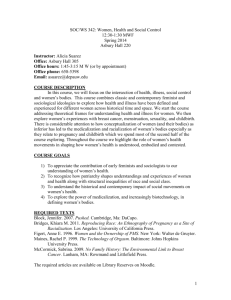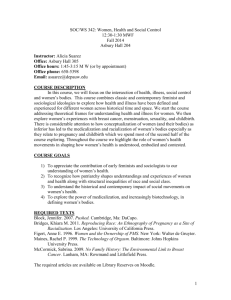“Distorted Medicalization” of Senile Dementia: The Japanese case
advertisement
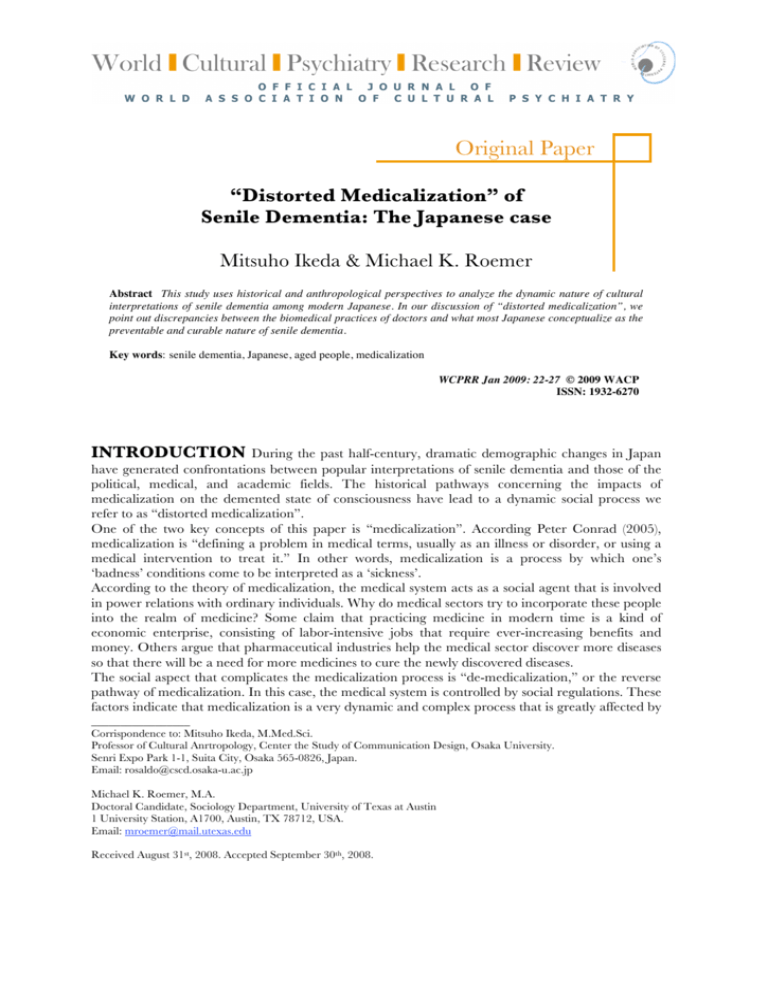
Original Paper “Distorted Medicalization” of Senile Dementia: The Japanese case Mitsuho Ikeda & Michael K. Roemer Abstract This study uses historical and anthropological perspectives to analyze the dynamic nature of cultural interpretations of senile dementia among modern Japanese. In our discussion of “distorted medicalization”, we point out discrepancies between the biomedical practices of doctors and what most Japanese conceptualize as the preventable and curable nature of senile dementia. Key words: senile dementia, Japanese, aged people, medicalization WCPRR Jan 2009: 22-27 © 2009 WACP ISSN: 1932-6270 INTRODUCTION During the past half-century, dramatic demographic changes in Japan have generated confrontations between popular interpretations of senile dementia and those of the political, medical, and academic fields. The historical pathways concerning the impacts of medicalization on the demented state of consciousness have lead to a dynamic social process we refer to as “distorted medicalization”. One of the two key concepts of this paper is “medicalization”. According Peter Conrad (2005), medicalization is “defining a problem in medical terms, usually as an illness or disorder, or using a medical intervention to treat it.” In other words, medicalization is a process by which one’s ‘badness’ conditions come to be interpreted as a ‘sickness’. According to the theory of medicalization, the medical system acts as a social agent that is involved in power relations with ordinary individuals. Why do medical sectors try to incorporate these people into the realm of medicine? Some claim that practicing medicine in modern time is a kind of economic enterprise, consisting of labor-intensive jobs that require ever-increasing benefits and money. Others argue that pharmaceutical industries help the medical sector discover more diseases so that there will be a need for more medicines to cure the newly discovered diseases. The social aspect that complicates the medicalization process is “de-medicalization,” or the reverse pathway of medicalization. In this case, the medical system is controlled by social regulations. These factors indicate that medicalization is a very dynamic and complex process that is greatly affected by _________________ Corrispondence to: Mitsuho Ikeda, M.Med.Sci. Professor of Cultural Anrtropology, Center the Study of Communication Design, Osaka University. Senri Expo Park 1-1, Suita City, Osaka 565-0826, Japan. Email: rosaldo@cscd.osaka-u.ac.jp Michael K. Roemer, M.A. Doctoral Candidate, Sociology Department, University of Texas at Austin 1 University Station, A1700, Austin, TX 78712, USA. Email: mroemer@mail.utexas.edu Received August 31st, 2008. Accepted September 30th, 2008. “DISTORTED MEDICALIZATION” OF SENILE DEMENTIA: THE JAPANESE CASE historical changes. In this paper, we are proposing that the Japanese culture has molded the medicalization process based on ways in which most people interpret the mental state of the elderly. The other key concept is the disease/illness dichotomy. Medical anthropologists often distinguish between ‘disease’ and ‘illness’. A ‘disease’ is defined by the profession of modern medicine, and ‘illness’ is defined by ordinary people. By distinguishing between ‘disease’ and ‘illness’, anthropologists are able to compare the medical profession’s interpretations with those of society’s in general. According to this terminology, medicalization is process by which one’s views of ‘illness’ come to be interpreted as a ‘disease’. Recently, the Japanese medical profession tried to introduce a new disease category into society; however, for the most part, people continue to accept and translate this term as the original illness concept. This is our first example of social dynamism under medicalization. When the biomedical term for senile dementia, or ‘chihô’, was first introduced in Japan, people were not interested in how doctors explained it medically. Instead, this disease concept, chihô, has always been interpreted as the more common illness concept, ‘boke’ (a term discussed in the following section). After the 1970s, the newly emerging social problem of the increase of elderly senile dementia, or ‘rôjinsei chihô-shô’, provoked horrible images of insane people. By the end of 1990s, though, under the influence of advanced brain scientists, Japanese thought that dementia could be prevented by exercising daily, reading aloud, and performing arithmetic calculations, for instance. These types of preventatives are called ‘boke bôshi’, which literarily translates as “dementia prevention” — a phrase that has been popularized by a mobile game machine that was designed for this purpose. Today, preventing senile dementia has become a national concern for all Japanese. THE PHENOMENOLOGY OF BOKE AND CHIHÔ Boke is a very important folk concept that describes a certain state of dementia in Japan. The verb form of boke is ‘bokeru’, a common word that can be translated as “to become disoriented”. This term covers not only senile dementia as a disease concept but also as a broader illness concept, and it refers to a deviated state of consciousness — from minor mental states to severe sickness conditions. The disease term for dementia (‘chihô’) is more specifically a medical symptom that is often adjoined with the terminological suffix for ‘diseases’ or ‘symptoms,’ as in ‘chihô-shô’. The different meanings and cultural inferences have left Japanese with the dilemma of whether to adopt a stigmatized label of dementia or to try to escape from this strictly medical diagnosis. Another important distinction is that, on the one hand, the word chihô has the fatalistic nuance of being incurable. The word boke, however, is more ambiguous and implies that it can be prevented or cured. Another perspective is that, often, Japanese do not criticize the medicalization process directly but ignore it by creating a cultural distinction between a disease and an illness. Today, most people have not completely accepted the concept of dementia as a disease, and opportunistically they translate what the medical field calls a disease into an illness as part of their cultural cognitive framework. In general, whether viewed as preventable or curable or not, Japanese express fear of the demented state of consciousness (i.e. chihô and boke). But why do they fear it? There are several social reasons we address in this paper. Traditionally, it is very important for Japanese to be socially involved. In most cases, Japanese seem to be unable to accept that one can forget or be unable to carry out one’s culturally reinforced obligations of give-and-take in daily social networks (Traphagan, 1998). When the demented break their reciprocal relationships, however, people do not feel angry but take pity on them because they are, typically, excluded from these networks and other intimate social circles. World Cultural Psychiatry Research Review 2009, 4(1): 22-27 23 IKEDA, M. ROEMER, M.K. Japanese prefer to understand the demented not from the biomedical concept but from their own cultural conceptualizations. There are other reasons why Japanese tend to rely on this ‘illness’ conceptualization. In Japan, medical pluralism is very popular. People are very opportunistic and pragmatic when seeking good health, and they allow for a relativistic perspective in this plural medical system. This kind of medical tradition encourages Japanese to maintain their well-being from an illness perspective rather than a disease one. If we observe the Japanese health condition superficially, it is easy to conclude that the degree of medicalization is quite high. On the other hand, it is also easy to find Japanese who resist medicalization and maintain illness concepts. The social trend against medicalization seems to be another side of de-medicalization. AN OUTLINE OF THE HISTORY OF DEMENTIA IN JAPAN The first event that signaled a social problem of the elderly in Japan occurred in 1968 when the National Welfare Council conducted a general survey on “bedridden elderly” (‘netakiri-rôjin’). In 1972, five years after this survey, a famous female writer, Sawako Ariyoshi, published a sensational book, The Twilight Years, which sold over a million copies. In her novel the protagonist, Akiko (a housewife and a part-time employee in law firm), takes care of her vulnerable father-in-law, Shigezô, who suffers from dementia (Ariyoshi, 1987). The original Japanese title of her novel, Kôkotsu-No-Hito, or “The One Who Goes into Ecstasy,” is still used to exemplify Japanese demented elderly today. After Ariyoshi’s novel was published, people started to distinguish between chihô and boke. Chihô was seen as a disease term that medical doctors used in official settings. Boke, however, was viewed as an illness term that people used as a folk idiom for distress or, mainly, senile dementia. Still, boke has a wide range of usages, from minor age-related memory loss to severe insanity. These applications have continued for over thirty years. Since then, the accelerated population growth of the elderly in Japan has spurred psychiatrists to analyze dementia from a biomedical perspective. This lead more people to make strong connections between chihô and senile insanity, and chihô became a stigmatized label in Japanese society. Until the mid-1970s, people have maintained that boke is a relatively non-stigmatized illness folk concept. But when the medicalization of aged people was accelerated, chihô became common in the vernacular, in part because mass media focused on chihô as a threat to the elderly. As a result of Japan’s rapidly aging society, government-supported medical services for older Japanese were introduced in the mid-1970s. For instance, from 1975 to 1984 the government offered a “free-from-pay” policy for medical costs for individuals over 70 years old. Subsequently, the nation confronted the major problem of “shakaiteki-nyûin,” literally “socialized hospitalization.” This refers to the custom in which people were hospitalized not because of a sickness, necessarily, but because they lacked family members who could care for them. There were not enough well organized national or local service systems that could offer daily assistance and care for aged persons. Eventually, “socialized hospitalization” pushed national health insurance expenditures beyond sustainability and the program was terminated. In response, in 1985 governmental health policies changed from the free-from-pay policy to the “share-for-pay” policy. The government tended to suppress hospitalization expenditures for all people. In the end, disabled elderly were excluded from hospitals, and family members were confronted again with the problem of “bedridden elderly.” The government and related private companies promoted national level discussions on this topic. For example, they held a symposium 24 “DISTORTED MEDICALIZATION” OF SENILE DEMENTIA: THE JAPANESE CASE entitled, “Why has the number of housebound, bedridden elderly increased in Japan?” Some journalists highlighted the seemingly utopian welfare systems of Scandinavian countries, especially Sweden, and they criticized the Japanese domestic medical system. This was also the time when the Japanese discussed unpaid housewives, especially housewives and daughters-in-law, or “yome”, who were spending countless hours caring for aging family members. Referring to these women, people were reminded of the cliché, “Who is it that is caring for our housebound, bedridden elderly today?” This inquiry continued until today. “Preventing” Dementia There are two particularly important historical points concerning the medicalization of elderly in the new millennium. One is the enforcement of the Law for Welfare Care Insurance (Kaigo hoken-hô) in 2000, and the other is the systematic reform of this law in April 2006. With these reforms, the government has been able to afford expenditures and manpower for home-helpers, instead of suppressing the costs for “socialized hospitalization” inpatients. Additionally, the government has proposed a national level campaign for “preventative nursing” (kaigo yobô). In Japanese yobô literally means “prevention” or “protection” in public health. In this campaign, the elderly are recommended to do physical exercises as a means of rehabilitation and have periodic diet and oral hygiene checkups. Under the name of the “preventative nursing” campaign, government policy has focused on both the involvement of the welfare system and the rearrangement of social support systems for aged people. The Renaming Process of Chihô Another political issue that has gained national attention in the past four years is the destigmatization of senile dementia, or chihô-shô. The Ministry of Health, Labor, and Welfare (MHLW) and Geronto-psychiatrists, especially some members of the Japanese Psycho-geriatric Society, began to discuss renaming elderly senile dementia (rôjinsei chihô-shô) to a more prejudice-free term. After four meetings, by the end of 2004 the advisory board recommended to the government that they should replace chihô-shô with the term ninchi-shô (Note 1). It is worth saying that this procedure was not a nosological change. They only altered the indexical name of dementia but maintained the original diagnostic classification. More importantly, social stigmas remained. This political decision caused some confusion for the Japanese. The advisory board claims that this new word, ninchi-shô, is de-stigmatized. However, this word has other meanings in civil law terminology. For instance, ninchi is associated with “recognizing a real child of single mother” by denominating father. In the sciences ‘ninchi’ denotes ‘cognition’, as in psychology or cognitive sciences. Even though the advisory board members were aware of these problems, from a political standpoint they preferred to de-stigmatize chihô rather than avoid terminological confusions. By using ninchi-shô, it appears they were not very successful in completely de-stigmatizing the disease, though. This brings up two more critical concerns: do these political processes indicate the beginning of demedicalization, or are these processes simply camouflaging the continuous medicalization of dementia? We would argue ‘No’ to the first question and ‘Yes’ to the latter. At least most Japanese do not interpret this process as the de-medicalizing of a certain kind of disease. The stigmas associated with chihô are still present in the new term ninchi-shô because the disease label has changed but the social situation regarding dementia has not. Unfortunately, the advisory board members did not understand fully that the social problems entangled with the stigma cannot be resolved by simply renaming the disease. World Cultural Psychiatry Research Review 2009, 4(1): 22-27 25 IKEDA, M. ROEMER, M.K. RETHINKING “MEDICALIZATION” At this time we need to discuss more precisely the medicalization process of dementia. According to sociologists, this process can be divided into two categories based on the different subjects of medicalization. One is the medicalization of “deviance,” for example insanity or substance dependency, and the other is the medicalization of “normal” life course processes, such as pregnancy, birth, aging, or menopause. Many sociologists warn that this term can be understood in a political sense, especially indicating a criticism of medical power. It is important to remember that this concept should be used as a valuefree term for analyzing social phenomena. In this case, because chihô was originally used as a medical term to indicate a demented state of consciousness, chihô has always been a disease concept. When ordinary people hear this word, they imagine the stereotype of a demented patient. Clearly, the Geronto-psychiatrists who participated in the advisory board were cognizant of these impressions. Although the renaming process had potential for de-medicalizing dementia, the social conditions have not changed with the introduction of the new word. The use of this word ‘ninchi-shô’ is politically correct, but the modality it was introduced to the people was incorrect. The advisory board decided to eliminate the stigmatized word from the disease, yet people still sense the nuanced stigmatization of the disorder. We refer to this kind of entangled situation as “distorted medicalization” to highlight the dynamic nature of this social process. Technology provides an escape from Medicalization In general, medical industries and medical policies help promote the medicalization process. At the very least, they can be catalysts for medicalization. The medicalization of dementia has progressed very slowly in Japan. The Japanese Psycho-geriatric Society was founded in 1986, only 22 years ago, and its legitimization as an academic society came two years later. That was the time of the modern medicalization of the elderly when the free-from-pay policy was first enacted. Also during that period, the Ministry of Health, the former MHLW, decided to launch a major decade-long health and welfare project for aged people entitled, “The Gold Plan of 1989-1998.” The government supported nationwide research and developed centers of multidisciplinary studies on senile dementia. Additionally, medical diagnostic technology has pushed this academic field in a scientific direction. In the mid-1980s, Magnetic Resonance Imaging, or MRI, first sold in Japan. By the mid-1990s many major hospitals had introduced the same or similar machines to take part in these diagnostic trends. Some hospitals have Magnetic Resonance Angiography (MRA) to detect functional imaging of the human brain. This is a diagnostic technique that can be useful in detecting brain functions — like a periodic checkup of a ship or car, and it is nicknamed ‘nô-dokku’ (literally “brain-docking”). Today this imaging technology is contributing to the development of functional analysis related to brain mapping. For instance, a newly emerging broad academic genre called “brain science” is renowned among higher multidisciplinary academic fields, especially cognitive sciences and imaging sciences. DISCUSSION As previously stated, the medicalization process refers to the defining of a problem or a distress in modern medical terms and/or using a medical intervention to treat it. Mental illness is a good example of a problem that is the object of medicalization. Senile dementia, especially Alzheimer’s disease (AD), can take a similar pathway of medicalization in United States or 26 “DISTORTED MEDICALIZATION” OF SENILE DEMENTIA: THE JAPANESE CASE Europe. Since defining chihô as a medical term, the medicalization of aged people in Japan has remained virtually unchanged, even after the word chihô was renamed to ninchi-shô. Because of its long-lasting cultural influence, the folk concept of boke has influenced the people’s understanding that dementia can be prevented or corrected. From the perspective of the Gerontopsychiatrics advisory board, they succeeded in eliminating the negative nuance of the word chihô. But the board members apparently did not consider the cultural aspects of the word boke, which resist medicalization. Such oversight is problematic because the Japanese government’s authorities tend to neologize terminologies without considering its socio-cultural connotations. Instead of discussing these important themes, they planed to organize a civil volunteer system, the Ninchi-Shô Sapôtâ, to care for elderly dementia patients. Three years after launching the national campaign for recruiting a million supporters in four years (from 2005 to 2009), the program has struggled to make significant progress. The renaming process provided only a superficial change for most Japanese. The obstacle is not so much about the word chihô but the cultural interpretations of chihô and now ninchi-shô. The word boke is ambiguous, flexible, and dynamic, and - as most Japanese understand it it is preventable and even curable to an extent. Today, young and middle-aged Japanese are playing Nintendo© games as a means of “dementia prevention” (boke bôshi). It is clear that there is a tremendous discrepancy between the lives of elderly who actually have dementia and those who fear its effects and hope to avoid it. There is no cognitive bridge passing over this deep generational groove. One might say that the people who still include boke in their lexicon understand that the national-level movement to treat senile dementia cannot eliminate an illness’ image by superficially renaming a it. Consequently, Japanese are living in a process of “distorted medicalization.” NOTES 1. For a report of the advisory board on discussing the replace word of chihô, visit: “Chihô” ni kawaru yôgo ni kansuru kentô-kai. Online. “Chihô” ni kawaru yôgo ni kansuru kentô-kai hôkokusho http://www.mhlw.go.jp/shingi/2004/12/s1224-17.html, Site visited 30 January, 2008 REFERENCES Ariyoshi S. The twilight years. Tokyo, Kodansha Internationals, 1987 Conrad P. The Sifting Engines of Medicalization. Journal of Health and Social Behavior, 46: 3-14, 2005 Traphagan JW. Localizing senility: Illness and agency among older Japanese. Journal of Cross-Cultural Gerontology, 13: 81-98, 1998 World Cultural Psychiatry Research Review 2009, 4(1): 22-27 27

